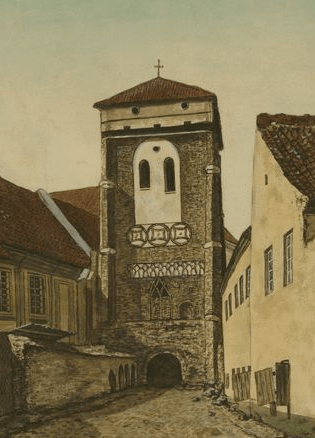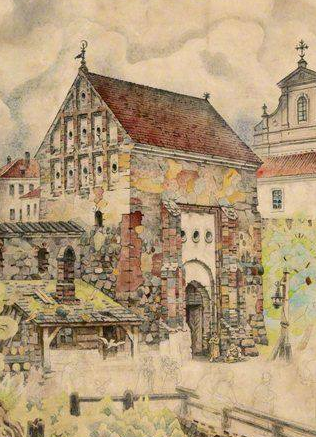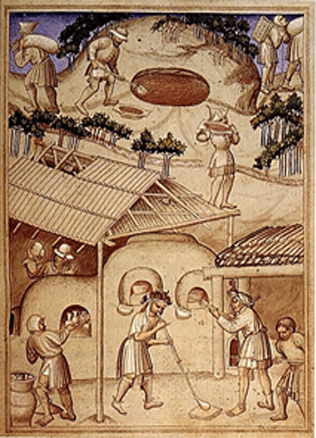Parish Churches: a Long Way to God’s House
Until the very mid-20th century a parish church was considered a most important community gathering place, the significance of which transcended the boundary of religious life. At the time when GDL received Catholic baptism (1387), the density of churches in Western Europe was so high that a parish member living farthest from the church could hear the church bells ringing. The erection of churches was first and foremost the concern of GDL rulers, Władysław II Jagiełło and Vytautas. Shortly after the baptism, the majority of churches were built in the core of the country: Vilnius, Ukmergė, Maišiagala, Lyda, Nemenčinė, Medininkai, Krėva; two churches were built in the remote Lithuanian enclaves of Haina and Obolcy. Towards the end of Vytautas reign, 27 churches were functioning in Vilnius diocese, and 7 churches in Samogitian diocese. In the mid-15th century, following the rulers’ example, noblemen started constructing churches as well. In the 16th century, local petty nobility started joining efforts in order to build churches. Churches were also founded by bishops in their holdings. The proportions of church founders, from the ruler to noblemen and the Church, were in line with GDL land tenure structure. By the mid-16th century, the Great Duke of Lithuania had founded about one third of churches, those built by noblemen accounted for about two thirds of all churches, whereas the number of churches built by the Church was about 5 percent.
In the late 15th century Vilnius diocese boasted 130 churches, Samogitian diocese had 19 churches. Half a century later the number of churches was 259 and 45, respectively. In the Samogitian diocese, the area of which was smaller, the number of churches built was almost six times less compared to the situation in Vilnius diocese. At that time, Vilnius diocese was among the largest in Catholic Europe. Its parishes were also large, e.g., in the mid-16th century one parish covered 870 km² on average, whereas in different Polish dioceses the average area covered by parishes ranged from 25 to 60 km². The analysis of the “gaps” in the parish network should not ignore the fact that GDL was a country covered with woods, with a low density of population. The territory of Vilnius diocese embraced Orthodox lands as well, therefore almost all Catholic churches were located in the western part of the diocese. Actually, in this part of the diocese parish density was twice as high.
The Care for the Souls of Nobles and the Mores of the Paupers
During the construction of new churches, an even distribution of parishes all over the country was of little concern. Every landlord would build a church in his estate, with certain provision allocation. Both rulers and noblemen, built churches pursuing their self-interests. In the foundations, two most important motives, serving as an impetus for the construction of a church, are mentioned: exaltation of the glory of God and concern over the salvation of ancestors’ souls (later their own souls).
The names of ancestors mentioned during the prayers were supposed both to ease the destiny of the souls in the afterlife and guarantee the remembrance of the family and relatives.
Many noblemen, wishing to emulate the ruler, erected churches in the centre of their holdings. (Goštautai in Geranainys (Hieraniony), Kęsgailos in Deltuva, Mantgirdai in Yvija, etc.), thus giving more representational and symbolic value to them.
It was only in early 16th century that churches for subordinates started to be erected. The foundation acts of Veisiejai, Nočia, Gervėčiai, Krinkai churches and Panevėžys chapel specify s to that the aforementioned churches had to be built due to the following reason: larges distances to the nearest church prevented local residents (founders’ subordinates) from attending church service on Sundays and Saturdays; peasants were living in sinful cohabitation, their children were dying unbaptized.
The founders of Panevėžys chapel and Veisiejai church expressed concern that their subordinates living in remote areas from church worshipped animals and reptiles in forests.
There is mention in the Veisiejai church foundation act (1526) of pagan customs still observed. Furthermore, it contains a description of how local inhabitants had to risk their lives on the way to church, in order to receive the Sacraments. Allegedly, they had to cover as many as 35 km to reach the nearest church in Merkinė. On the way, they also had to cross “the widest and largest” river Nemunas, which posed a great danger to many travellers, resulting in drowning. An analogous situation and a hazard-strewn path to the nearest church is also mentioned in the Nočia church foundation of 1529.
Piety and the Distance to the Church
There were instances in the 16th century when local residents left the place to live elsewhere, resulting in a sharply declining church attendance. After the Muscovites burnt down the Myadzyel church and annihilated local population, the church was restored in another place. A chapel was built in the place of the old church, thus maintaining respect for the burials held there. In the late 16th century, Butkiškės church was located on the greenfield, with neither a village nor a town in the close proximity. Members in the benefice were scattered all over the territory.
In medieval Europe, an obligation was established for all believers to receive all religious services only in the appropriated parish. In this way, control was exercised over all parishioners, to see that they attended duly during the service and performed all religious obligations. Such a system also defended a local pastor’s right to his parishioners’ offerings. Therefore, it was important to set parish boundaries. During the first century after baptism, there was no basis for competition in DGL among the pastors of neighbouring parishes. Back then, parishes were open, churches were separated from each other by the so-called “nobody’s land.” This was the territory, the inhabitants of which found the distance to church too big. The calculation of an average parish area does not necessarily mean that all the Catholics living in that territory attended church and received religious services.
In Poland and Prussia, during the formation of parish network, it was usual for only one village representative to go to church on Sundays, but even he would not go to a church located more than a dozen kilometres away.
In Vilnius and Samogitian dioceses, believers from more remote areas used to come to church to receive the Sacraments such as baptize a newborn baby or marry. However, there is no mention of longer distances to be covered only to attend the Holy Mass on Sunday.
Reda Bružaitė



